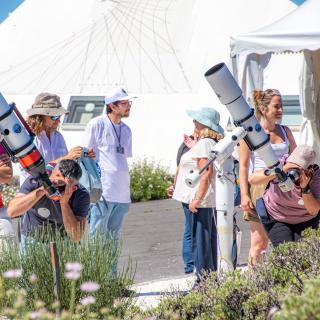It may interest you
-
 The Instituto de Astrofísica de Canarias (IAC) and the Canary, La Palma Reserve of the Biosphere Foundation have signed a document agreeing on actions to be taken in prevention, early warning and rapid response to exotic invading species on the Island of La Palma, a World Biosphere Reserve.Advertised on
The Instituto de Astrofísica de Canarias (IAC) and the Canary, La Palma Reserve of the Biosphere Foundation have signed a document agreeing on actions to be taken in prevention, early warning and rapid response to exotic invading species on the Island of La Palma, a World Biosphere Reserve.Advertised on -
 El Observatorio del Teide recibe este fin de semana a cerca de 1.000 visitantes en sus tradicionales Jornadas de Puertas Abiertas, organizadas por el Instituto de Astrofísica de Canarias (IAC) con motivo del solsticio de verano. Esta iniciativa, ya consolidada en el calendario divulgativo del IAC, ofrece a la ciudadanía la oportunidad de acercarse a la ciencia y a las infraestructuras científicas de Canarias de forma directa y cercana. La actividad está coordinada conjuntamente por el propio Observatorio y por la Unidad de Comunicación y Cultura Científica (UC3) del IAC, en el marco de lasAdvertised on
El Observatorio del Teide recibe este fin de semana a cerca de 1.000 visitantes en sus tradicionales Jornadas de Puertas Abiertas, organizadas por el Instituto de Astrofísica de Canarias (IAC) con motivo del solsticio de verano. Esta iniciativa, ya consolidada en el calendario divulgativo del IAC, ofrece a la ciudadanía la oportunidad de acercarse a la ciencia y a las infraestructuras científicas de Canarias de forma directa y cercana. La actividad está coordinada conjuntamente por el propio Observatorio y por la Unidad de Comunicación y Cultura Científica (UC3) del IAC, en el marco de lasAdvertised on -
 The Instituto de Astrofísica de Canarias (IAC) has initiated a project of science outreach in the Tenerife-II prison in El Rosario, with the aim of bringing knowledge about the Universe to the prisoners, as well as to the educational and other working personnel at that centre. This initiative is taken in the framework of the commitment of the IAC to the popularization of science as a tool for inclusión and social transformation. The project is led by the astrophysicist, and IAC researcher David Aguado and is a continuation of a first experiment in 2024 in the Madrid V prison at Soto del RealAdvertised on
The Instituto de Astrofísica de Canarias (IAC) has initiated a project of science outreach in the Tenerife-II prison in El Rosario, with the aim of bringing knowledge about the Universe to the prisoners, as well as to the educational and other working personnel at that centre. This initiative is taken in the framework of the commitment of the IAC to the popularization of science as a tool for inclusión and social transformation. The project is led by the astrophysicist, and IAC researcher David Aguado and is a continuation of a first experiment in 2024 in the Madrid V prison at Soto del RealAdvertised on